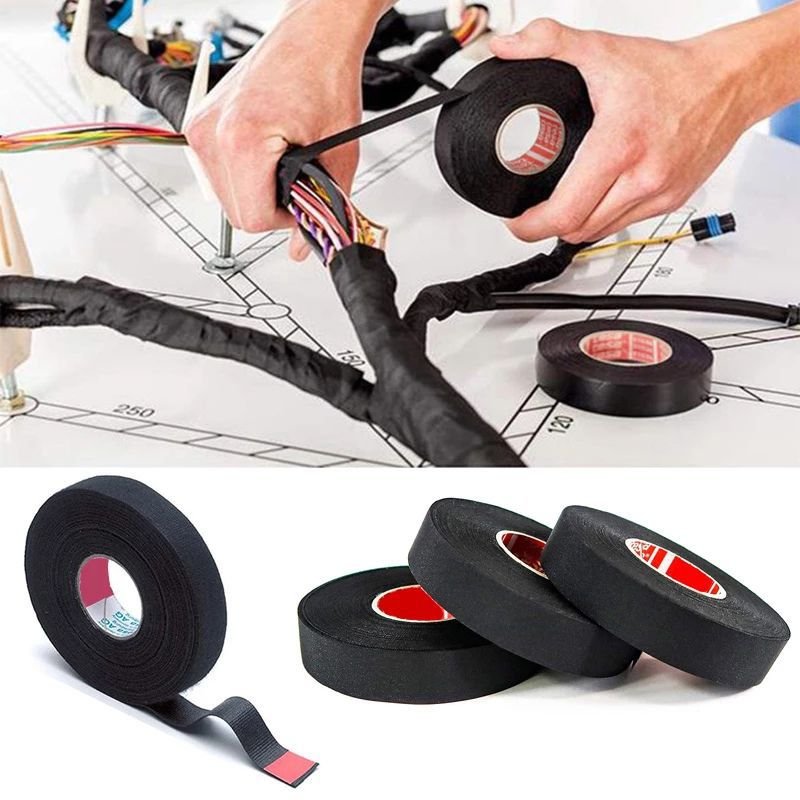Ever grabbed a roll of electrical tape and wondered, Can this really handle heat? It’s a fair question. Whether you’re fixing a wire, bundling cables, or working on a car engine, knowing how heat resistant electrical tape is can save you from short circuits, melted insulation, or even fire hazards.
Let’s dive into the science, real-world use, and best alternatives for when temperatures rise.
What Is Electrical Tape and How Does It Work?
Electrical tape is a pressure-sensitive adhesive tape used mainly to insulate electrical wires and other materials that conduct electricity. It’s usually made from PVC (Polyvinyl Chloride) or vinyl, which offers flexibility and insulation properties.
When wrapped around electrical connections, it prevents current leaks, protects from short circuits, and resists minor temperature changes.
Common Materials in Electrical Tape:
| Material | Features | Typical Use |
| PVC | Flexible, durable, affordable | General wiring and repairs |
| Vinyl | Weather-resistant, easy to apply | Automotive and outdoor use |
| Rubber | High stretch, excellent sealing | Industrial insulation |
| Silicone | Extreme heat resistance | High-temperature environments |
Each material reacts differently under heat. While PVC is the most popular, silicone and rubber-based tapes are preferred in areas with higher thermal exposure.
Is Electrical Tape Heat Resistant?
The short answer: Yes, but only to a point.
Electrical tape is heat resistant to moderate temperatures, not heatproof. Standard PVC tapes can withstand up to 80°C (176°F), while premium versions go up to 105°C (221°F). Specialized silicone-based electrical tapes can handle temperatures as high as 260°C (500°F).
Heat Resistance Comparison Table
| Tape Type | Material | Max Temperature | Common Application |
| PVC Electrical Tape | Polyvinyl Chloride | 80°C (176°F) | General repairs |
| Vinyl Electrical Tape | Vinyl Compound | 90°C (194°F) | Automotive wiring |
| Rubber Electrical Tape | Rubber Blend | 105°C (221°F) | Outdoor electricals |
| Silicone Electrical Tape | Silicone Rubber | 260°C (500°F) | Engine and HVAC systems |
In short, electrical tape can resist heat, but its durability depends heavily on material composition, brand, and how it’s applied.
Factors That Influence Heat Resistance
Even the best tape can fail under certain conditions. Several factors influence how much heat electrical tape can handle before it starts losing its grip or melting.
1. Material and Thickness
Thicker and high-quality materials hold up better against high temperatures. A rubber or silicone base provides better insulation than cheap PVC.
2. Brand Quality
Trusted brands like 3M, Nitto, and Tesa design tapes that meet industrial safety standards. Generic or no-name brands often compromise on adhesive quality and melting point.
3. Exposure Duration
A few minutes near a heat source is different from hours of sustained heat. Prolonged exposure degrades adhesive faster, even if the temperature is within rated limits.
4. Environmental Conditions
Humidity, dust, or oil can impact adhesive strength. Direct sunlight can also make vinyl-based tapes brittle over time.
Pro Tip: Always check the temperature rating printed on the tape label before use.
What Happens When Electrical Tape Gets Too Hot?
When tape surpasses its rated temperature, things can go wrong quickly. The adhesive begins to soften and lose its grip, making it peel away from the surface.
Here’s what typically happens:
- The adhesive melts and slips off wires.
- Insulation weakens, exposing live conductors.
- Toxic fumes may release from overheated PVC.
- The tape becomes sticky and brittle once it cools.
Example:
If you use regular electrical tape under a car hood near the exhaust, the continuous heat may cause it to harden and crack. Over time, this can lead to short circuits or electrical fires.
Heat-Resistant Alternatives to Electrical Tape
In extreme environments, regular tape won’t cut it. Here are some superior options that provide better insulation and heat resistance.
1. Heat Shrink Tubing
Made from polyolefin, heat shrink tubing offers permanent, professional-grade insulation. It contracts tightly around wires when exposed to heat, sealing them completely.
Best for: Automotive, industrial, and marine wiring.
Temperature Range: Up to 135°C (275°F).
2. Silicone Self-Fusing Tape
This tape doesn’t rely on adhesive—it bonds to itself when stretched and wrapped. It’s waterproof, chemical-resistant, and highly heat-tolerant.
Best for: Engine repairs, plumbing, HVAC systems.
Temperature Range: Up to 260°C (500°F).
3. Fiberglass Insulating Tape
Constructed from woven glass fibers, it’s used in industrial setups where extreme heat and abrasion are common.
Best for: Transformers, electric motors, industrial furnaces.
Temperature Range: Up to 500°C (932°F).
Comparison Table
| Product | Heat Resistance | Flexibility | Ideal Application |
| Electrical Tape | Up to 105°C | High | General wiring |
| Heat Shrink Tubing | Up to 135°C | Low | Permanent insulation |
| Silicone Tape | Up to 260°C | Medium | High-heat repairs |
| Fiberglass Tape | Up to 500°C | Low | Industrial insulation |
These options not only resist heat better but also provide long-term protection and professional results.
When and Where You Should (and Shouldn’t) Use Electrical Tape
Electrical tape works well for certain tasks—but not all.
✅ Safe Applications
- Temporary repairs for low-voltage wires
- Bundling or labeling cables
- Insulating minor home electrical connections
- Indoor wiring under controlled temperatures
❌ Unsafe Applications
- Around open flames or heaters
- In engine bays or near exhausts
- Long-term outdoor exposure
- High-voltage or high-temperature circuits
Quick Safety Tip: If the area exceeds 105°C, switch to heat-resistant silicone or fiberglass options.
Real-Life Case Studies and Examples
Case Study 1: Automotive Repair
A mechanic repairing a dashboard wiring harness used 3M Super 33+ electrical tape rated for 105°C. Even after months of exposure to engine heat, the tape maintained its hold, showing excellent heat endurance.
Case Study 2: HVAC Maintenance
A technician used standard PVC tape to insulate wires near an air conditioner compressor. Within two weeks, the adhesive degraded due to constant heat. Switching to silicone self-fusing tape solved the issue permanently.
Quote:
“In electrical safety, it’s not about what works once—it’s about what lasts.” – James Holbrook, Industrial Electrician
Frequently Asked Questions About Electrical Tape and Heat Resistance
Can electrical tape melt?
Yes. When exposed to temperatures above its rating, the adhesive and backing can melt or deform.
Is black electrical tape more heat resistant?
No. The color doesn’t determine heat resistance—the material and brand do.
Can it catch fire?
It can if placed near open flames or extreme heat. Always check for flame-retardant labeling.
Is it waterproof and heatproof?
It’s water-resistant but not fully waterproof or heatproof. For waterproof sealing, silicone or rubber-based alternatives are better.
How can I identify heat-rated tape?
Look for specifications on the packaging such as UL 510 rating or explicit temperature range.
Real-World Applications of Heat-Resistant Electrical Tape
Even with temperature limitations, this tape still shines in several environments:
- Home Repairs: Securing appliance cords and indoor wiring.
- Automotive Maintenance: Protecting dashboard and trunk wiring away from direct engine heat.
- Industrial Cabling: Insulating moderate-heat equipment lines.
- Electronics: Bundling cables in computers or power supplies.
Example:
A homeowner repairing a broken lamp wire can safely use PVC electrical tape, as indoor temperatures stay well within its heat tolerance.
Final Verdict — Is Electrical Tape Heat Resistant Enough?
Electrical tape offers moderate heat resistance, making it ideal for everyday repairs, indoor wiring, and general maintenance. However, it’s not meant for extreme heat conditions. When temperatures exceed 105°C, it begins to degrade, lose adhesion, and potentially release fumes.
If your project involves engines, heaters, or industrial environments, go for high-temperature silicone or fiberglass insulating tapes. They provide both safety and durability under heat stress.
Key Takeaways:
- Standard electrical tape withstands up to 80–105°C.
- High-heat options like silicone can reach 260°C or more.
- Always check the temperature rating before use.
- Use heat-resistant alternatives for high-heat environments.
Remember, electrical tape is heat resistant, not heatproof. Choosing the right type for the right temperature can prevent hazards and extend the life of your electrical projects.
Related Resources
- 3M Electrical Tape Specifications
- Nitto Heat Resistant Tape Products
- OSHA Electrical Safety Guidelines
In short: Electrical tape can take the heat—but only up to a point. Beyond that, it’s better to switch to materials designed to thrive where others fail. Safety and the right tools always go hand in hand.










Leave a Reply